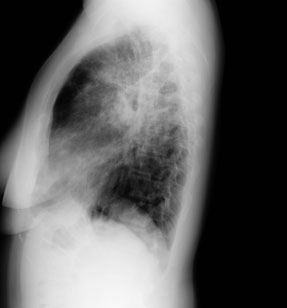MKSAP Quiz: 6-month history of exertional dyspnea
A 49-year-old woman is evaluated for a 6-month history of exertional dyspnea and nonproductive cough that had an insidious onset. She has not noticed any particular triggers for her cough. She has no history of asthma, airway disease, reflux, or aspiration. She has never smoked. She has had no chemical or industrial exposures, has not been in contact with birds, has not been in a hot tub recently, and has not had recent travel. She works as a computer programmer. She has no family history of atopy or asthma, and she takes no medications.
On physical examination, temperature is 37.6°C (99.7°F), blood pressure is 122/76 mm Hg, pulse rate is 84/min, and respiration rate is 16/min; BMI is 24. Auscultation of the heart and lungs is normal. There are no palpable lymph nodes and no notable skin findings.
Lung volumes and spirometry are normal; DLCO is mildly reduced at 75% of predicted. Chest radiographs are shown. The patient has not had any previous radiographs.


Which of the following is the most likely diagnosis?
A. Asbestosis
B. Cryptogenic organizing pneumonia
C. Heart failure
D. Idiopathic pulmonary fibrosis
E. Sarcoidosis
Answer and Critique
The correct answer is E: Sarcoidosis. This question can be found in MKSAP 16 in the Neurology section, item 101.
The most likely diagnosis is sarcoidosis. Sarcoidosis is an idiopathic disorder that most often involves the lungs and is characterized by non-necrotizing granulomatous inflammation that may involve lymph nodes and the lung parenchyma. Upper-lobe predominance is the characteristic distribution of the infiltrates in the lungs on chest imaging; this is often most apparent on the lateral view. Despite rather extensive radiographic abnormalities, patients with sarcoidosis may have normal or minimally abnormal pulmonary function testing as another clue to the diagnosis. The diagnosis of sarcoidosis requires histopathologic demonstration of organ involvement with noncaseating granulomatous inflammation in conjunction with the appropriate clinical and radiographic findings and the exclusion of other diseases.
Asbestosis, cryptogenic organizing pneumonia, heart failure, and idiopathic pulmonary fibrosis are unlikely in this patient because these diseases typically have lower lung zone predominance. In addition, this patient provides no occupational history that is consistent with asbestos exposure. The patient does not have physical examination findings consistent with heart failure (S3, jugular venous distention, crackles) or idiopathic pulmonary fibrosis (bibasilar “Velcro” inspiratory crackles). Patients with cryptogenic organizing pneumonia most typically present subacutely with cough, fatigue, and low-grade fever often mistaken for pneumonia.
Key Point
- Sarcoidosis is characterized by upper-lobe predominance of infiltrates in the lungs on chest imaging; this is often most apparent on the lateral view.



